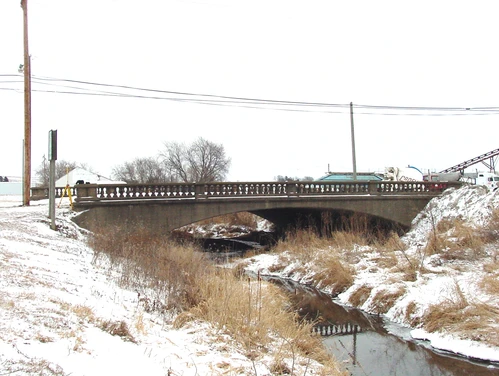- Year constructed: 1910
- Alternate name: Otter Creek Bridge
- Bridge type: Concrete Luten Arch
- National Register of Historic Places status: Listed
- Length: 66 feet
- Width: 40 feet
- Spans: 1
- FHWA: 012570
- Jurisdiction: City of West Union
- Location: South Vine Street over Otter Creek in West Union, Section 17, T94N-R8W (Union Township)
Details
In 1910 the Fayette County Board of Supervisors received an urgent citizens' petition, asking for a permanent bridge to carry Vine Street in West Union over Otter Creek. The petitioners requested a 66-foot-wide structured to match the adjacent street width, and they concluded by saying, "This is a dangerous place, being located between two lines of Railroad track close together." In late winter of 1910 the supervisors solicited competitive bids to build the Vine Street Bridge. A contract was awarded that March to N.M. Stark and Company of Des Moines for $8,475. The award to Stark was hardly surprising. From about the turn of the century until 1913, Stark built virtually all of the county's concrete and steel bridges, holding a virtual monopoly on Fayette County bridge construction and even providing the designs for most of the structures. The design that Stark used for the concrete arches was the patented elliptical arch of Indianapolis engineer Daniel Luten. Stark was a licensee for Luten, building Luten arches under a patent royalty agreement. The Vine Street Bridge was built by Stark that year. Since its completion, the structure has carried vehicular traffic, in unaltered condition.
N.M. Stark was vigorous in his promotion of concrete for bridge construction in the early 20th century. Touting the Luten arch as an economical alternative to the steel truss, he was the state's most prolific concrete bridge builder during this time. This was due in large part to counties such as Fayette, Story and Marshall, which built numerous bridges under essentially non-competitive contracts with Stark in the years around 1910. But the Iowa State Highway Commission regarded Stark --with his patented bridges and monopolistic county contracts--as an exemplar of the worst of bridge contracting in the state. Beginning in 1913, the highway commission aggressively attacked Stark and the Luten patent, eventually getting the patent declared non-valid in court and getting Stark indicted for bid-rigging. As a result, Stark's business plummeted, and one of Iowa's most successful bridge builders soon faded into obscurity by the early 1920s. The Vine Street Bridge is a typically configured example of this widespread and controversial structural type. And with its 66-foot span, the Vine Street Bridge is distinguished as one of the longest-span Luten arches in Iowa.
Adapted from Fraser 1992
Areas Served
- Fayette
